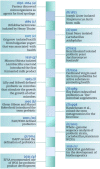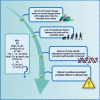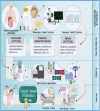Probiotics, their action modality and the use of multi-omics in metamorphosis of commensal microbiota into target-based probiotics
- PMID: 36185680
- PMCID: PMC9523698
- DOI: 10.3389/fnut.2022.959941
Probiotics, their action modality and the use of multi-omics in metamorphosis of commensal microbiota into target-based probiotics
Abstract
This review article addresses the strategic formulation of human probiotics and allows the reader to walk along the journey that metamorphoses commensal microbiota into target-based probiotics. It recapitulates what are probiotics, their history, and the main mechanisms through which probiotics exert beneficial effects on the host. It articulates how a given probiotic preparation could not be all-encompassing and how each probiotic strain has its unique repertoire of functional genes. It answers what criteria should be met to formulate probiotics intended for human use, and why certain probiotics meet ill-fate in pre-clinical and clinical trials? It communicates the reasons that taint the reputation of probiotics and cause discord between the industry, medical and scientific communities. It revisits the notion of host-adapted strains carrying niche-specific genetic modifications. Lastly, this paper emphasizes the strategic development of target-based probiotics using host-adapted microbial isolates with known molecular effectors that would serve as better candidates for bioprophylactic and biotherapeutic interventions in disease-susceptible individuals.
Keywords: bioprophylactics; biotherapeutics; host-adapted strains; human probiotics formulation; lactic acid bacteria; multi-omics; target-based probiotics.
Copyright © 2022 Idrees, Imran, Atiq, Zahra, Abid, Alreshidi, Roberts, Abdelgadir, Tipu, Farid, Olawale and Ghazanfar.
Conflict of interest statement
The authors declare that the research was conducted in the absence of any commercial or financial relationships that could be construed as a potential conflict of interest.
Figures






Similar articles
-
Strategies for the Identification and Assessment of Bacterial Strains with Specific Probiotic Traits.Microorganisms. 2022 Jul 10;10(7):1389. doi: 10.3390/microorganisms10071389. Microorganisms. 2022. PMID: 35889107 Free PMC article. Review.
-
Probiotics in digestive diseases: focus on Lactobacillus GG.Minerva Gastroenterol Dietol. 2015 Dec;61(4):273-92. Minerva Gastroenterol Dietol. 2015. PMID: 26657927 Review.
-
Tackling probiotic and gut microbiota functionality through proteomics.J Proteomics. 2016 Sep 16;147:28-39. doi: 10.1016/j.jprot.2016.03.023. Epub 2016 Mar 18. J Proteomics. 2016. PMID: 27003613 Review.
-
Probiotics Mechanism of Action on Immune Cells and Beneficial Effects on Human Health.Cells. 2023 Jan 2;12(1):184. doi: 10.3390/cells12010184. Cells. 2023. PMID: 36611977 Free PMC article. Review.
-
Toward rational selection criteria for selection of probiotics in pigs.Adv Appl Microbiol. 2019;107:83-112. doi: 10.1016/bs.aambs.2019.03.003. Epub 2019 Apr 12. Adv Appl Microbiol. 2019. PMID: 31128749 Review.
Cited by
-
Where Biology Meets Engineering: Scaling Up Microbial Nutraceuticals to Bridge Nutrition, Therapeutics, and Global Impact.Microorganisms. 2025 Mar 2;13(3):566. doi: 10.3390/microorganisms13030566. Microorganisms. 2025. PMID: 40142459 Free PMC article. Review.
-
Exploration adhesion properties of Liquorilactobacillus and Lentilactobacillus isolated from two different sources of tepache kefir grains.PLoS One. 2024 Feb 7;19(2):e0297900. doi: 10.1371/journal.pone.0297900. eCollection 2024. PLoS One. 2024. PMID: 38324577 Free PMC article.
-
Characterization of Lactobacillus spp. as Probiotic and Antidiabetic Potential Isolated from Boza, Traditional Fermented Beverage in Turkey.Int J Microbiol. 2024 Jun 10;2024:2148676. doi: 10.1155/2024/2148676. eCollection 2024. Int J Microbiol. 2024. PMID: 38962395 Free PMC article.
-
Immune-adjuvant effect of vitamin A and probiotics supplementation on humoral response to cell culture rabies vaccine in rabbits.3 Biotech. 2023 Jul;13(7):232. doi: 10.1007/s13205-023-03631-x. Epub 2023 Jun 12. 3 Biotech. 2023. PMID: 37323857 Free PMC article.
-
The Gut Microbiome as a Catalyst and Emerging Therapeutic Target for Parkinson's Disease: A Comprehensive Update.Biomedicines. 2024 Aug 2;12(8):1738. doi: 10.3390/biomedicines12081738. Biomedicines. 2024. PMID: 39200203 Free PMC article. Review.
References
-
- Metchnikoff E. The Prolongation of Life: Optimistic Studies. New York, NY: Springer Publishing Company; (2004).
Publication types
LinkOut - more resources
Full Text Sources
Molecular Biology Databases
Miscellaneous

